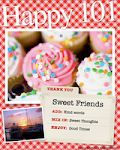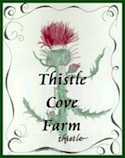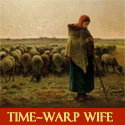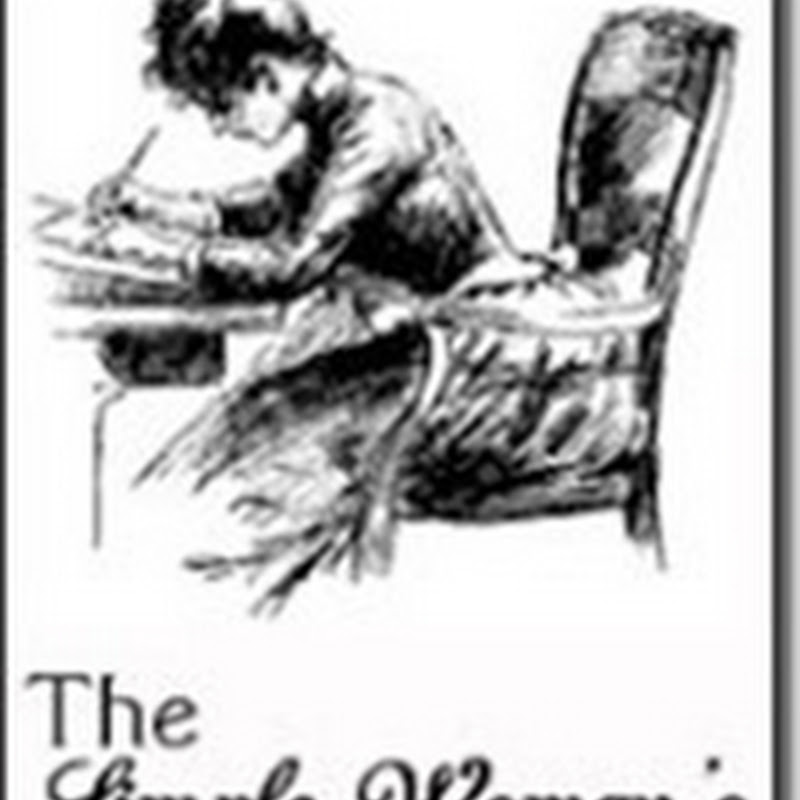The Tortoise or the Hare ~ Does Slow and Steady Always Win the Race?
As a child I enjoyed reading Aesop’s Fables. What I always liked best about fables was that they used animals and they always taught a lesson. Jesus used parables when He taught, often using farm life or some other part of daily life that His hearers would recognize and relate to.
As a child I enjoyed reading Aesop’s Fables. What I always liked best about fables was that they used animals and they always taught a lesson. Jesus used parables when He taught, often using farm life or some other part of daily life that His hearers would recognize and relate to.
Probably my favorite Aesop’s Fable is The Tortoise and the Hare. You know the story…One day a Hare came across a Tortoise and began making fun of him because he was so slow. Tired of being teased once again, the Tortoise challenged the Hare to a race. His victory assured, the Hare took the old Tortoise up on his offer. After the fox had set the course, the race was on! The Hare was ahead in no time and decided that he had plenty of time to take a nap. Upon waking he looked toward the finish line only to see that the Tortoise was crossing the finish line and he had lost the race! Lesson: “Slow and steady wins the race.”
Slow and steady…does that always win the race in every circumstance? Well, let’s put that in homeschool terms. What about reading?
When a homeschool family begins their journey from the beginning, reading is one of those scary subjects on the list. Can you remember how you learned how to read? I couldn’t. With such a huge variety of reading programs out there, some guaranteeing fast results and some out for the long-term, scope shaping journey, how does one pick and choose what will work for their children? I’ll show you two tried and true favorites, Teach Your Child to Read in 100 Easy Lessons (the Hare) and Hooked On Phonics (the tortoise). Both of these methods are fine phonics-based methods and I have used both with great success.
Why phonics? Simply because it works! Several years ago, at a Christian Home Educators of Ohio convention, I listened to Samuel Bloomenfeld discuss the utter failure of the “Look-Say/Whole Word” method that so many public schools have been using. This method attempts of teach reading by causing children to “memorize” what certain often used words “look” like. Basically, once these key words are memorized by sight – not sounding out, but what they look like – the rest of their reading instruction ends up just being a guessing game. This Look-say/Whole Word method was originally created to teach deaf people how to read. The program was such a failure that it is no longer used in them – BUT – it is still used in three out of four government schools. Sounds like one more reason to teach them at home.
 Enter: The Hare
Enter: The Hare
Teach Your Child to Read in 100 Easy Lessons is a product of DISTAR, published by the Science Research Associates, Inc. (SRA). Remember those fun and teachable SRA’s we used to do in third grade? These are the same folks! I always enjoyed doing those little SRA’s and I was thrilled to find out that this was the same company.
In the Introduction, they take what Samuel Bloomenfeld told us at CHEO by quoting Robert Benjamin from his book Making Schools Work, “Many schools continue to employ instructional methods that have been proven ineffective. The staying power of the look-say or whole-word method of teaching beginning reading is perhaps the most flagrant example of this failure to instruct effectively.” As we all know, if a child is a good reader, the whole world opens up to them. DISTAR has proven to be very effective with young readers; especially pre-schoolers.
As the title implies, the book consists of 100 lessons that last roughly one-half hour each day. My advice is to NOT skip any lessons, as they build upon each other. By the time your child finishes the book they will be reading at whopping second grade level! And your child will not be the only one who benefits…as the book says, “After you complete the program, you’ll know more about teaching reading then most public school teachers, because you will have carefully observed and participated in the step-by-step development of your child’s reading skills.” As we all know, parents learn, or re-learn, right along with their children.
Once you have read through the Introduction you will then turn to the Parents’ Guide. This portion will give you the outline for “an effective sequence for teaching reading.” The basics of which are: 1) to begin with simple exercises, 2) teaching reading skills, 3) exercises change slow, in small ways, so that it is easy for the child, and 4) very clear communication with the child. From there, you will cover the development of the DISTAR program and the research involved, Communicating Clearly with the Child and Making Teaching Easier.
Then, we get into something interesting. DISTAR uses a very special “funny” print and how words are spelled, or their “orthography.” As we know, because our language is a peculiar mixed of Greek, Latin and French, many of our letters do not make the same sounds every time they are used. DISTAR helps a child understand these difference early one by using a “funny” print. Something I can’t do here is show it to you, but only inform you that it includes all the phonics-related symbols that we grew up with: long/short; blends such as qu, ch, sh, th, sh, etc.
Walking further into the book we come to Getting Ready. DISTAR has produced a Pronunciation Guide. This is very simple, easy to use and will probably look slightly familiar to most as your memories of learning to read take shape. The guide will give you the letter Symbol (m), how the letter is to be pronounced (mmm), a word example (as in ram), voiced or whispered (the symbol for voiced is v, whispered is w) and the guide will let you know which lesson this concept is introduced in (lesson 1).
Two of the keys to phonics is saying the words slowly and sounding out words. The first few lessons will begin with saying letter sounds slowly. Each sound, and words (as you get further into the book), will be written in the way you should teach your child to say them. Each word will begin by you putting your finger on the BIG dot, you will quickly move your finger to the letter to be sounded out and move on. If a word has more than on letter/sound, you will move quickly to the next letter/sound. After you have shown your child the sounds that the letters make, then they will do it with you two or three times, then they will sound out the letters/sounds themselves. If it is an actual word, each time you will repeat the sounds a little faster until the sounds mmm, eee run smoothly together to form the word “me.”
Slow and steady…does that always win the race in every circumstance? Well, let’s put that in homeschool terms. What about reading?
When a homeschool family begins their journey from the beginning, reading is one of those scary subjects on the list. Can you remember how you learned how to read? I couldn’t. With such a huge variety of reading programs out there, some guaranteeing fast results and some out for the long-term, scope shaping journey, how does one pick and choose what will work for their children? I’ll show you two tried and true favorites, Teach Your Child to Read in 100 Easy Lessons (the Hare) and Hooked On Phonics (the tortoise). Both of these methods are fine phonics-based methods and I have used both with great success.
Why phonics? Simply because it works! Several years ago, at a Christian Home Educators of Ohio convention, I listened to Samuel Bloomenfeld discuss the utter failure of the “Look-Say/Whole Word” method that so many public schools have been using. This method attempts of teach reading by causing children to “memorize” what certain often used words “look” like. Basically, once these key words are memorized by sight – not sounding out, but what they look like – the rest of their reading instruction ends up just being a guessing game. This Look-say/Whole Word method was originally created to teach deaf people how to read. The program was such a failure that it is no longer used in them – BUT – it is still used in three out of four government schools. Sounds like one more reason to teach them at home.
 Enter: The Hare
Enter: The Hare
Teach Your Child to Read in 100 Easy Lessons is a product of DISTAR, published by the Science Research Associates, Inc. (SRA). Remember those fun and teachable SRA’s we used to do in third grade? These are the same folks! I always enjoyed doing those little SRA’s and I was thrilled to find out that this was the same company.
In the Introduction, they take what Samuel Bloomenfeld told us at CHEO by quoting Robert Benjamin from his book Making Schools Work, “Many schools continue to employ instructional methods that have been proven ineffective. The staying power of the look-say or whole-word method of teaching beginning reading is perhaps the most flagrant example of this failure to instruct effectively.” As we all know, if a child is a good reader, the whole world opens up to them. DISTAR has proven to be very effective with young readers; especially pre-schoolers.
As the title implies, the book consists of 100 lessons that last roughly one-half hour each day. My advice is to NOT skip any lessons, as they build upon each other. By the time your child finishes the book they will be reading at whopping second grade level! And your child will not be the only one who benefits…as the book says, “After you complete the program, you’ll know more about teaching reading then most public school teachers, because you will have carefully observed and participated in the step-by-step development of your child’s reading skills.” As we all know, parents learn, or re-learn, right along with their children.
Once you have read through the Introduction you will then turn to the Parents’ Guide. This portion will give you the outline for “an effective sequence for teaching reading.” The basics of which are: 1) to begin with simple exercises, 2) teaching reading skills, 3) exercises change slow, in small ways, so that it is easy for the child, and 4) very clear communication with the child. From there, you will cover the development of the DISTAR program and the research involved, Communicating Clearly with the Child and Making Teaching Easier.
Then, we get into something interesting. DISTAR uses a very special “funny” print and how words are spelled, or their “orthography.” As we know, because our language is a peculiar mixed of Greek, Latin and French, many of our letters do not make the same sounds every time they are used. DISTAR helps a child understand these difference early one by using a “funny” print. Something I can’t do here is show it to you, but only inform you that it includes all the phonics-related symbols that we grew up with: long/short; blends such as qu, ch, sh, th, sh, etc.
Walking further into the book we come to Getting Ready. DISTAR has produced a Pronunciation Guide. This is very simple, easy to use and will probably look slightly familiar to most as your memories of learning to read take shape. The guide will give you the letter Symbol (m), how the letter is to be pronounced (mmm), a word example (as in ram), voiced or whispered (the symbol for voiced is v, whispered is w) and the guide will let you know which lesson this concept is introduced in (lesson 1).
Two of the keys to phonics is saying the words slowly and sounding out words. The first few lessons will begin with saying letter sounds slowly. Each sound, and words (as you get further into the book), will be written in the way you should teach your child to say them. Each word will begin by you putting your finger on the BIG dot, you will quickly move your finger to the letter to be sounded out and move on. If a word has more than on letter/sound, you will move quickly to the next letter/sound. After you have shown your child the sounds that the letters make, then they will do it with you two or three times, then they will sound out the letters/sounds themselves. If it is an actual word, each time you will repeat the sounds a little faster until the sounds mmm, eee run smoothly together to form the word “me.”
As mentioned earlier, DISTAR insists NO SKIPPING ALLOWED! They recommend that even though a child may read at a faster rate than the program’s sequence, we must remember that “The goal of decoding instruction is to make decoding an automatic practice, not something that requires and great deal of thinking or a great deal of effort.” A person who reads well spends very little time mentally sounding out words. By learning in sequence, one learns wholly. If your mind has been trained well, the sounding out process is automatic and produces and person who, not only reads well and reads quickly, but absorbs and maintains more of what he has read.
Now before this all sounds too overwhelming, and as we get into what a lesson actually consists of, one thing you must know is all lessons are scripted! Your script is written in red – but don’t let it go to your head! J You don’t have to worry about not explaining a concept or new sound correctly, it’s all laid out for you on every page. Even what to expect from your child is there! Making the program easy on the parent is one of the reasons TYC has been such a success.
The daily lessons, divided up by “tasks,” may conclude in as quickly as 10 minutes, but I would recommend that you schedule 20 minutes, especially in the beginning, until you are your child are more familiar with what is expected. These lessons should take place everyday for 5 or even 7 days per week. DO NOT COMPROMISE! As mentioned earlier, these lessons build upon each other and continuity, just like consistency in discipline, is the key to your success. You may even have days when you do two lessons in one day, as some lessons go quickly. However, use your own judgment so as not to load your child with too information. If only working on reading is enough for your child at this time, do not overwhelm him with Sound Writing.
On occasion, once you actually get started, there may be times when you wonder what the exercise has to do with anything your child is learning; as some things seem to go off on a completely different tangent. Hang with it…Have you ever noticed that if you have something weighing on your mind, or if you child has a big test coming up, that if you get your mind off of that particular thing for a few moments and go to something else, that you are better able to deal with it a little later? This, to me, must be the idea that the writers had by the time you get to task 4 of the lessons. By the time you get to task 4, you will review what was already taught in task 1; task 5 will review what was taught in task 2. You will be amazed at how successful that first lesson will have been and what your child retained!
I use a similar technique when I am teaching form a book (what Charlotte Mason referred to as Whole Book Learning). While am reading, my children will be doing something with their hands – drawing, coloring, painting, latch-hooking a rug, etc. The act of keeping their hands occupied helps to keep their minds free to accept what they are learning on an auditory level. Their retention level is far greater than if they were only half-listening because they were so bored their hands were looking for something to do. So, when TYC begins with one task and seems to an entirely different way only to come back to the original task, I believe that this same concept is what they are aiming at…teach something meaningful, get away for just a short bit so that the information can sink in and…bingo! Lesson learned!
Enter: the Tortoise
This was the first reading program that I had used. Hooked on Phonics (HOP) now has several programs to offer, but, why mess with perfection? Their original program, which we will discuss here, is now called Hooked on Phonics Classic. It is SO much fun when that big HOP box arrives! Inside your will find 7 workbooks with lessons, stories and activities; 9 audio cassettes; 3 sets of fun stickers; 9 sets of flash cards; 1 parent guide. Yes, what TYC is in simplicity, HOP has ALL the bells and whistles! Another find…remember those SRA’s that we talked about earlier? THEY ARE HERE! But let’s not get ahead of ourselves…
The first thing to do is to listen to Tape 1, the instruction tape. This will give you a great run-down of what you can expect as your use HOP. You next step will be to open up the yellow Book One, grab the yellow flash cards and the white tape 1. Each tape will lead your child, completely through what they are to say and do. (Of course, brand new readers will need your help until they become familiar with what is expected.) The tapes take the child through the sounds and letters that are on the flash cards. After they are familiar, then you will move to the book and Read Out Loud! The first section is “Say the Sound.” Each letter is represented by an object beginning with that letter: a-apple, b-bell, c-cat… In no time at all, your child will be moving on to the letter “a” and actually putting together words! From one of the first lessons they will be putting “a” and “t” together and READING the words: at, bat, cat, fat, hat, mat, pat, rat, sat. Each lesson ends in review and by the time you get to the third review, your child will know 25 words! By the time they finish the very first book, they will have gone through the whole alphabet and will be reading whole sentences! My children were SO excited when they could read sentences. Book 1 focuses on sight words that everyone reads time and time again, day after day.
Each book works in progression as their reading abilities grow. HOP teaches children to read in a deeper, more complex way. Book/tape/flash cards 2 teaches ending sounds, more complex sight words and beginning sounds. Book/tape/flash cards 3 teaches more complex beginning and ending sounds and long vowel and other sounds. Book/tape/flash cards 4 gets a little more in-depth with diphthong, “schwa” and other sounds, plus more vowel and combination sounds. Set 5 covers combination sounds, silent letters and prefixes. Set 6 gets deeper into suffixes, silent letters, and gets into larger, 4 and 5 syllable words. Book 7 is a complete reading review book; this book is actually referred to at specific points during the whole lesson plan.
Now, we can’t forget those SRA’s. I’m glad to say that my daughters enjoyed these just as much as I had as a child. There are 100 SRA’s, called Power Builders, that range from beginner’s reading level to advanced and are divided up into 3 levels. The beginner’s level has a short little story of one- and two-syllable words, then has various activities such as comprehension questions, sounding out words and “yes” or “no” (true or false) questions. The intermediate section is for those who have completed approximately to Book 3 and has a much longer story (one and a half pages, smaller print, more complex words), comprehension questions, Lean About Words (definitions, etc.), and thinking questions. Upper level has far more complex stories, comprehension questions, vocabulary, and word studies. In all three sections the stories are everything from fiction, non-fiction, science, mini-biographies. They are all very interesting. A small word of warning: these are not necessarily from a Christian perspective and may mention evolution as fact, millions of years, etc.
You Decide…
Now before this all sounds too overwhelming, and as we get into what a lesson actually consists of, one thing you must know is all lessons are scripted! Your script is written in red – but don’t let it go to your head! J You don’t have to worry about not explaining a concept or new sound correctly, it’s all laid out for you on every page. Even what to expect from your child is there! Making the program easy on the parent is one of the reasons TYC has been such a success.
The daily lessons, divided up by “tasks,” may conclude in as quickly as 10 minutes, but I would recommend that you schedule 20 minutes, especially in the beginning, until you are your child are more familiar with what is expected. These lessons should take place everyday for 5 or even 7 days per week. DO NOT COMPROMISE! As mentioned earlier, these lessons build upon each other and continuity, just like consistency in discipline, is the key to your success. You may even have days when you do two lessons in one day, as some lessons go quickly. However, use your own judgment so as not to load your child with too information. If only working on reading is enough for your child at this time, do not overwhelm him with Sound Writing.
On occasion, once you actually get started, there may be times when you wonder what the exercise has to do with anything your child is learning; as some things seem to go off on a completely different tangent. Hang with it…Have you ever noticed that if you have something weighing on your mind, or if you child has a big test coming up, that if you get your mind off of that particular thing for a few moments and go to something else, that you are better able to deal with it a little later? This, to me, must be the idea that the writers had by the time you get to task 4 of the lessons. By the time you get to task 4, you will review what was already taught in task 1; task 5 will review what was taught in task 2. You will be amazed at how successful that first lesson will have been and what your child retained!
I use a similar technique when I am teaching form a book (what Charlotte Mason referred to as Whole Book Learning). While am reading, my children will be doing something with their hands – drawing, coloring, painting, latch-hooking a rug, etc. The act of keeping their hands occupied helps to keep their minds free to accept what they are learning on an auditory level. Their retention level is far greater than if they were only half-listening because they were so bored their hands were looking for something to do. So, when TYC begins with one task and seems to an entirely different way only to come back to the original task, I believe that this same concept is what they are aiming at…teach something meaningful, get away for just a short bit so that the information can sink in and…bingo! Lesson learned!
Enter: the Tortoise

This was the first reading program that I had used. Hooked on Phonics (HOP) now has several programs to offer, but, why mess with perfection? Their original program, which we will discuss here, is now called Hooked on Phonics Classic. It is SO much fun when that big HOP box arrives! Inside your will find 7 workbooks with lessons, stories and activities; 9 audio cassettes; 3 sets of fun stickers; 9 sets of flash cards; 1 parent guide. Yes, what TYC is in simplicity, HOP has ALL the bells and whistles! Another find…remember those SRA’s that we talked about earlier? THEY ARE HERE! But let’s not get ahead of ourselves…
The first thing to do is to listen to Tape 1, the instruction tape. This will give you a great run-down of what you can expect as your use HOP. You next step will be to open up the yellow Book One, grab the yellow flash cards and the white tape 1. Each tape will lead your child, completely through what they are to say and do. (Of course, brand new readers will need your help until they become familiar with what is expected.) The tapes take the child through the sounds and letters that are on the flash cards. After they are familiar, then you will move to the book and Read Out Loud! The first section is “Say the Sound.” Each letter is represented by an object beginning with that letter: a-apple, b-bell, c-cat… In no time at all, your child will be moving on to the letter “a” and actually putting together words! From one of the first lessons they will be putting “a” and “t” together and READING the words: at, bat, cat, fat, hat, mat, pat, rat, sat. Each lesson ends in review and by the time you get to the third review, your child will know 25 words! By the time they finish the very first book, they will have gone through the whole alphabet and will be reading whole sentences! My children were SO excited when they could read sentences. Book 1 focuses on sight words that everyone reads time and time again, day after day.
Each book works in progression as their reading abilities grow. HOP teaches children to read in a deeper, more complex way. Book/tape/flash cards 2 teaches ending sounds, more complex sight words and beginning sounds. Book/tape/flash cards 3 teaches more complex beginning and ending sounds and long vowel and other sounds. Book/tape/flash cards 4 gets a little more in-depth with diphthong, “schwa” and other sounds, plus more vowel and combination sounds. Set 5 covers combination sounds, silent letters and prefixes. Set 6 gets deeper into suffixes, silent letters, and gets into larger, 4 and 5 syllable words. Book 7 is a complete reading review book; this book is actually referred to at specific points during the whole lesson plan.
Now, we can’t forget those SRA’s. I’m glad to say that my daughters enjoyed these just as much as I had as a child. There are 100 SRA’s, called Power Builders, that range from beginner’s reading level to advanced and are divided up into 3 levels. The beginner’s level has a short little story of one- and two-syllable words, then has various activities such as comprehension questions, sounding out words and “yes” or “no” (true or false) questions. The intermediate section is for those who have completed approximately to Book 3 and has a much longer story (one and a half pages, smaller print, more complex words), comprehension questions, Lean About Words (definitions, etc.), and thinking questions. Upper level has far more complex stories, comprehension questions, vocabulary, and word studies. In all three sections the stories are everything from fiction, non-fiction, science, mini-biographies. They are all very interesting. A small word of warning: these are not necessarily from a Christian perspective and may mention evolution as fact, millions of years, etc.
You Decide…
So, now it’s up to you. Which is better, the tortoise or the hare? You decide. But I warn you – your child’s excitement in learning how to read may even rekindle a long lost love for reading in you that was misplaced long, long ago.
Contacts:
Teach Your Children to Read in 100 Easy Lessons is available in multiple resources. Some are: Christian Book Distributors (CBD) www.Christianbook.com, 1-800-247-4784; Farm Country General Store www.homeschoolfcgs.com, 1-800-551-FARM.
Hooked on Phonics www.hop.com, 1-800-ABCDEFG.
Contacts:
Teach Your Children to Read in 100 Easy Lessons is available in multiple resources. Some are: Christian Book Distributors (CBD) www.Christianbook.com, 1-800-247-4784; Farm Country General Store www.homeschoolfcgs.com, 1-800-551-FARM.
Hooked on Phonics www.hop.com, 1-800-ABCDEFG.
Blessings from Ohio...Kim<><




















 Edinburgh
Edinburgh








































































This comment has been removed by the author.
ReplyDeleteI will try for the third time to write this comment. I have having technical difficulties. I agree with everything you wrote about the phonics!! After 13 yrs of homeschooling I can attest to value of phonics. My dd, Kacy was reading high school level classics, like Jane Austen , after using these programs, in 5th and 6th grade. She still has a love of reading! I also love the Teaching a Child to Read in 100 Easy Lessons is very affordable! That is always a bonus. Just my 2 cents worth. :-)) Great post!
ReplyDelete